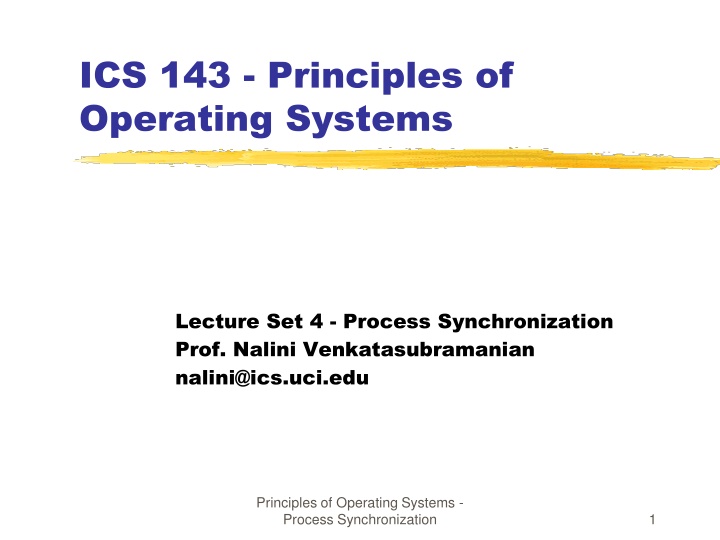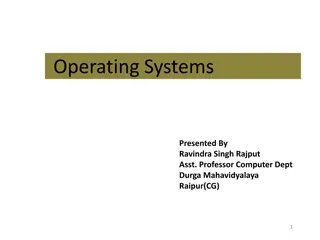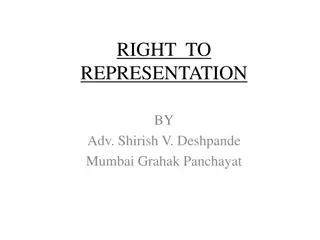Producer-Consumer Problem in Operating Systems
This content delves into the Producer-Consumer problem in operating systems, exploring the challenges of synchronization, bounded and unbounded buffers, and shared memory solutions. It discusses how producer and consumer processes interact and coordinate data exchange, highlighting key concepts such as critical sections and semaphores.
Download Presentation

Please find below an Image/Link to download the presentation.
The content on the website is provided AS IS for your information and personal use only. It may not be sold, licensed, or shared on other websites without obtaining consent from the author.If you encounter any issues during the download, it is possible that the publisher has removed the file from their server.
You are allowed to download the files provided on this website for personal or commercial use, subject to the condition that they are used lawfully. All files are the property of their respective owners.
The content on the website is provided AS IS for your information and personal use only. It may not be sold, licensed, or shared on other websites without obtaining consent from the author.
E N D
Presentation Transcript
ICS 143 - Principles of Operating Systems Lecture Set 4 - Process Synchronization Prof. Nalini Venkatasubramanian nalini@ics.uci.edu Principles of Operating Systems - Process Synchronization 1
Outline The Critical Section Problem Synchronization Hardware Semaphores Classical Problems of Synchronization Critical Regions Monitors Principles of Operating Systems - Process Synchronization 2
Producer-Consumer Problem Paradigm for cooperating processes; producer process produces information that is consumed by a consumer process. We need buffer of items that can be filled by producer and emptied by consumer. Unbounded-buffer places no practical limit on the size of the buffer. Consumer may wait, producer never waits. Bounded-buffer assumes that there is a fixed buffer size. Consumer waits for new item, producer waits if buffer is full. Producer and Consumer must synchronize.
Bounded Buffer using IPC (messaging) Producer repeat produce an item in nextp; send(consumer, nextp); until false; Consumer repeat receive(producer, nextc); consume item from nextc; until false;
Bounded-buffer - Shared Memory Solution Shared data var n; type item = .; var buffer: array[0..n-1] of item; in, out: 0..n-1; in :=0; out:= 0; /* shared buffer = circular array */ /* Buffer empty if in == out */ /* Buffer full if (in+1) mod n == out */ /* noop means do nothing */
Bounded Buffer - Shared Memory Solution Producer process - creates filled buffers repeat produce an item in nextp while in+1 mod n = out do noop; buffer[in] := nextp; in := in+1 mod n; until false;
Bounded Buffer - Shared Memory Solution Consumer process - Empties filled buffers repeat while in = out do noop; nextc := buffer[out] ; out:= out+1 mod n; consume the next item in nextc until false
Shared data Concurrent access to shared data may result in data inconsistency. Maintaining data consistency requires mechanisms to ensure the orderly execution of cooperating processes. Shared memory solution to the bounded-buffer problem allows at most (n-1) items in the buffer at the same time. Principles of Operating Systems - Process Synchronization 9
Bounded Buffer A solution that uses all N buffers is not that simple. Modify producer-consumer code by adding a variable counter, initialized to 0, incremented each time a new item is added to the buffer Shared data type item = .; var buffer: array[0..n-1] of item; in, out: 0..n-1; counter: 0..n; in, out, counter := 0; Principles of Operating Systems - Process Synchronization 10
Bounded Buffer Producer process - creates filled buffers repeat produce an item in nextp while counter = n do noop; buffer[in] := nextp; in := in+1 mod n; counter := counter+1; until false; Principles of Operating Systems - Process Synchronization 11
Bounded Buffer Consumer process - Empties filled buffers repeat while counter = 0 do noop; nextc := buffer[out] ; out:= out+1 mod n; counter := counter - 1; consume the next item in nextc until false; The statements counter := counter + 1; counter := counter - 1; must be executed atomically. Atomic Operations An operation that runs to completion or not at all. Principles of Operating Systems - Process Synchronization 12
Race Condition counter++ could be implemented as register1 = counter register1 = register1 + 1 counter = register1 counter-- could be implemented as register2 = counter register2 = register2 - 1 counter = register2 Consider this execution interleaving with count = 5 initially (we expect count = 5 in the end too): S0: producer execute register1 = counter {register1 = 5} S1: producer execute register1 = register1 + 1 {register1 = 6} S2: consumer execute register2 = counter {register2 = 5} S3: consumer execute register2 = register2 1 {register2 = 4} S4: producer execute counter = register1 {counter = 6 } S5: consumer execute counter = register2 {counter = 4 !!} Principles of Operating Systems - Process Synchronization 13
Problem is at the lowest level If threads are working on separate data, scheduling doesn t matter: Thread A Thread B x = 1; y = 2; However, What about (Initially, y = 12): Thread A Thread B x = 1; y = 2; x = y+1; y = y*2; What are the possible values of x? Or, what are the possible values of x below? Thread A Thread B x = 1; x = 2; X could be non-deterministic (1, 2??)
The Critical-Section Problem N processes all competing to use shared data. Structure of process Pi ----Each process has a code segment, called the critical section, in which the shared data is accessed. repeat entry section /* enter critical section */ critical section /* access shared variables */ exit section /* leave critical section */ remainder section /* do other work */ until false Problem Ensure that when one process is executing in its critical section, no other process is allowed to execute in its critical section. Principles of Operating Systems - Process Synchronization 15
Solution: Critical Section Problem - Requirements Mutual Exclusion If process Pi is executing in its critical section, then no other processes can be executing in their critical sections. Progress If no process is executing in its critical section and there exists some processes that wish to enter their critical section, then the selection of the processes that will enter the critical section next cannot be postponed indefinitely. Bounded Waiting A bound must exist on the number of times that other processes are allowed to enter their critical sections after a process has made a request to enter its critical section and before that request is granted. Principles of Operating Systems - Process Synchronization 16
Solution: Critical Section Problem - Requirements Assume that each process executes at a nonzero speed in the critical section. That is, assume that each process finishes executing the critical section once entered No assumption concerning relative speed of the n processes. Assume that a process can get stuck in its remainder section indefinitely, e.g., in a non- terminating while loop Principles of Operating Systems - Process Synchronization 17
Solution: Critical Section Problem -- Initial Attempt Only 2 processes, P0 and P1 General structure of process Pi (Pj) repeat entry section critical section exit section remainder section until false Processes may share some common variables to synchronize their actions. Principles of Operating Systems - Process Synchronization 18
Algorithm 1 Shared Variables: var turn: (0..1); initially turn = 0; turn = i Pi can enter its critical section Process Pi repeat while turn <> i do no-op; critical section turn := j; remainder section until false Satisfies mutual exclusion, but not progress. Principles of Operating Systems - Process Synchronization 19
Algorithm 1 Satisfies mutual exclusion The turn is equal to either i or j and hence one of Pi and Pj can enter the critical section Does not satisfy progress Example: Pi finishes the critical section and then gets stuck indefinitely in its remainder section. Then Pj enters the critical section, finishes, and then finishes its remainder section. Pj then tries to enter the critical section again, but it cannot since turn was set to i by Pj in the previous iteration. Since Pi is stuck in the remainder section, turn will be equal to i indefinitely and Pj can t enter although it wants to. Hence no process is in the critical section and hence no progress. We don t need to discuss/consider bounded wait when progress is not satisfied 20 20
Algorithm 2 Shared Variables var flag: array (0..1) of boolean; initially flag[0] = flag[1] = false; flag[i] = true Pi ready to enter its critical section Process Pi repeat flag[i] := true; while flag[j] do no-op; critical section flag[i]:= false; remainder section until false Satisfies mutual exclusion, but not progress. Principles of Operating Systems - Process Synchronization 21
Algorithm 2 Satisfies mutual exclusion If Pi enters, then flag[ i ] = true, and hence Pj will not enter. Does not satisfy progress Can block indefinitely . Progress requirement not met Example: There can be an interleaving of execution in which Pi and Pj both first set their flags to true and then both check the other process flag. Therefore, both get stuck at the entry section We don t need to discuss/consider bounded wait when progress is not satisfied 22 22
Algorithm 3 Shared Variables var flag: array (0..1) of boolean; initially flag[0] = flag[1] = false; flag[i] = true Pi ready to enter its critical section Process Pi repeat while flag[j] do no-op; flag[i] := true; critical section flag[i]:= false; remainder section until false Principles of Operating Systems - Process Synchronization 23
Algorithm 3 Does not satisfy mutual exclusion Example: There can be an interleaving of execution in which both first check the other process flag and see that it is false. Then they both enter the critical section. We don t need to discuss/consider progress and bounded wait when mutual exclusion is not satisfied 24 24
Algorithm 4 Combined Shared Variables of algorithms 1 and 2 Process Pi repeat flag[i] := true; turn := j; while (flag[j] and turn=j) do no-op; critical section flag[i]:= false; remainder section until false YES!!! Meets all three requirements, solves the critical section problem for 2 processes. Also called Peterson s solution Principles of Operating Systems - Process Synchronization 25
Algorithm 4 Satisfies mutual exclusion If one process enters the critical section, it means that either the other process was not ready to enter or it was this process turn to enter. In either case, the other process will not enter the critical section Satisfies progress If one process exits the critical section, it sets its ready flag to false and hence the other process can enter. Moreover, there is no interleaving in the entry section that can block both. Satisfies bounded wait If a process is waiting in the entry section, it will be able to enter at some point since the other process will either set its ready flag to false or will set to turn to this process. 26 26
Bakery Algorithm Critical section for n processes Before entering its critical section, process receives a number. Holder of the smallest number enters critical section. If processes Pi and Pj receive the same number, if i <= j, then Pi is served first; else Pj is served first. The numbering scheme always generates numbers in increasing order of enumeration; i.e. 1,2,3,3,3,3,4,4,5,5 Principles of Operating Systems - Process Synchronization 27
Bakery Algorithm (cont.) Notation - Lexicographic order(ticket#, process id#) (a,b) < (c,d) if (a<c) or if ((a=c) and (b < d)) max(a0, .an-1) is a number, k, such that k >=ai for i = 0, ,n-1 Shared Data var choosing: array[0..n-1] of boolean;(initialized to false) number: array[0..n-1] of integer; (initialized to 0) Principles of Operating Systems - Process Synchronization 28
Bakery Algorithm (cont.) repeat choosing[i] := true; number[i] := max(number[0], number[1], ,number[n-1]) +1; choosing[i] := false; for j := 0 to n-1 do begin while choosing[j] do no-op; while number[j] <> 0 and (number[j] ,j) < (number[i],i) do no-op; end; critical section number[i]:= 0; remainder section until false; Principles of Operating Systems - Process Synchronization 29
Supporting Synchronization Programs Shared Programs Higher-level API Locks Semaphores Monitors Send/Receive CCregions Hardware Load/Store Disable Ints Test&Set Comp&Swap We are going to implement various synchronization primitives using atomic operations Everything is pretty painful if only atomic primitives are load and store Need to provide inherent support for synchronization at the hardware level Need to provide primitives useful at software/user level
Hardware Solutions for Synchronization Load/store - Atomic Operations required for synchronization Showed how to protect a critical section with only atomic load and store pretty complex! Mutual exclusion solutions presented depend on memory hardware having read/write cycle. If multiple reads/writes could occur to the same memory location at the same time, this would not work. Processors with caches but no cache coherency cannot use the solutions In general, it is impossible to build mutual exclusion without a primitive that provides some form of mutual exclusion. How can this be done in the hardware??? How can this be simplified in software??? Principles of Operating Systems - Process Synchronization 31
Synchronization Hardware Test and modify the content of a word atomically - Test-and-set instruction function Test-and-Set (var target: boolean): boolean; begin Test-and-Set := target; target := true; end; Similarly SWAP instruction Principles of Operating Systems - Process Synchronization 32
Mutual Exclusion with Test- and-Set Shared data: var lock: boolean (initially false) Process Pi repeat while Test-and-Set (lock) do no-op; critical section lock := false; remainder section until false; Principles of Operating Systems - Process Synchronization 33
Bounded Waiting Mutual Exclusion with Test-and-Set var j : 0..n-1; key : boolean; repeat waiting [i] := true; key := true; while waiting[i] and key do key := Test-and-Set(lock); waiting [i ] := false; critical section j := i+1 mod n; while (j <> i ) and (not waiting[j]) do j := j + 1 mod n; if j = i then lock := false; else waiting[j] := false; remainder section until false; Principles of Operating Systems - Process Synchronization 34
Hardware Support: Other examples swap (&address, register) { /* x86 */ temp = M[address]; M[address] = register; register = temp; } compare&swap (&address, reg1, reg2) { /* 68000 */ if (reg1 == M[address]) { M[address] = reg2; return success; } else { return failure; } } load-linked&store conditional(&address) { /* R4000, alpha */ loop: ll r1, M[address]; movi r2, 1; sc r2, M[address]; beqz r2, loop; } /* Can do arbitrary comp */
Mutex Locks Previous solutions are complicated and generally inaccessible to application programmers OS designers build software tools to solve critical section problem Simplest is mutex lock Protect a critical section by first acquiring a lock and then releasing the lock Boolean variable indicating if lock is available or not Calls to acquire() and release() must be atomic Usually implemented via hardware atomic instructions But this solution requires busy waiting This lock therefore called a spinlock 36
acquire() and release() Semantics of acquire acquire(mutex_lock) { while Test&Set(mutex_lock)) ; /* busy wait */ } Semantics of release release(mutex_lock) { mutex_lock = 0; } Critical section implementation do { acquire (lock) critical section release (lock) remainder section } while (true); 37
Semaphore Semaphore S - integer variable (non-negative) used to represent number of abstract resources Can only be accessed via two indivisible (atomic) operations wait (S): while S <= 0 do no-op S := S-1; signal (S): S := S+1; P or wait used to acquire a resource, waits for semaphore to become positive, then decrements it by 1 V or signal releases a resource and increments the semaphore by 1, waking up a waiting P, if any If P is performed on a count <= 0, process must wait for V or the release of a resource. P(): proberen (to test) ; V() verhogen (to increment) in Dutch Principles of Operating Systems - Process Synchronization 38
Example: Critical Section for n Processes Shared variables var mutex: semaphore initially mutex = 1 Process Pi repeatwait(mutex); critical section remainder section signal (mutex); until false Principles of Operating Systems - Process Synchronization 39
Semaphore as a General Synchronization Tool Execute B in Pj only after A execute in Pi Use semaphore flag initialized to 0 Code: Pi . . . . . . A signal(flag) B Pj wait(flag) Principles of Operating Systems - Process Synchronization 40
Problem... Locks prevent conflicting actions on shared data Lock before entering critical section and before accessing shared data Unlock when leaving, after accessing shared data Wait if locked All Synchronization involves waiting Busy Waiting, uses CPU that others could use. This type of semaphore is called a spinlock. Waiting thread may take cycles away from thread holding lock (no one wins!) OK for short times since it prevents a context switch. Priority Inversion: If busy-waiting thread has higher priority than thread holding lock no progress! Should sleep if waiting for a long time For longer runtimes, need to modify P and V so that processes can block and resume. Principles of Operating Systems - Process Synchronization 41
Semaphore Implementation Define a semaphore as a record type semaphore = record value: integer; L: list of processes; end; Assume two simple operations block suspends the process that invokes it. wakeup(P) resumes the execution of a blocked process P. Principles of Operating Systems - Process Synchronization 42
Semaphore Implementation(cont.) Semaphore operations are now defined as wait (S): S.value := S.value -1; if S.value < 0 then begin add this process to S.L; block; end; signal (S): S.value := S.value +1; if S.value <= 0 then begin remove a process P from S.L; wakeup(P); end; Principles of Operating Systems - Process Synchronization 43
Block/Resume Semaphore Implementation If process is blocked, enqueue PCB of process and call scheduler to run a different process. Semaphores are executed atomically; no two processes execute wait and signal at the same time. Mutex can be used to make sure that two processes do not change count at the same time. If an interrupt occurs while mutex is held, it will result in a long delay. Solution: Turn off interrupts during critical section. Principles of Operating Systems - Process Synchronization 44
Deadlock and Starvation Deadlock - two or more processes are waiting indefinitely for an event that can be caused by only one of the waiting processes. Let S and Q be semaphores initialized to 1 P0 P1 wait(S); wait(Q); wait(Q); wait(S); . . . . . . signal (S) ; signal (Q); signal (S); Starvation- indefinite blocking. A process may never be removed from the semaphore queue in which it is suspended. signal (Q); Principles of Operating Systems - Process Synchronization 45
Two Types of Semaphores Counting Semaphore - integer value can range over an unrestricted domain. Binary Semaphore - integer value can range only between 0 and 1; simpler to implement. Can implement a counting semaphore S as a binary semaphore. Principles of Operating Systems - Process Synchronization 46
Classical Problems of Synchronization Bounded Buffer Problem Readers and Writers Problem Dining-Philosophers Problem Principles of Operating Systems - Process Synchronization 47
Bounded Buffer Problem Shared data type item = .; var buffer: array[0..n-1] of item; full, empty, mutex : semaphore; nextp, nextc :item; full := 0; empty := n; mutex := 1; Principles of Operating Systems - Process Synchronization 48
Bounded Buffer Problem Producer process - creates filled buffers repeat produce an item in nextp wait (empty); wait (mutex); add nextp to buffer signal (mutex); signal (full); until false; Principles of Operating Systems - Process Synchronization 49
Bounded Buffer Problem Consumer process - Empties filled buffers repeat wait (full ); wait (mutex); remove an item from buffer to nextc ... signal (mutex); signal (empty); consume the next item in nextc until false; Principles of Operating Systems - Process Synchronization 50























